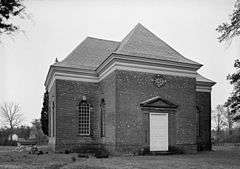Christ Church (Lancaster County, Virginia)
|
Christ Church | |
|
Photograph taken during the early stages of the restoration of Christ Church | |
  | |
| Nearest city | Weems, Virginia |
|---|---|
| Coordinates | 37°40′36.5″N 76°25′7″W / 37.676806°N 76.41861°WCoordinates: 37°40′36.5″N 76°25′7″W / 37.676806°N 76.41861°W |
| Area | 13 acres (5.3 ha) |
| Built | 1735 |
| Architect | Unknown |
| Architectural style | Georgian |
| NRHP Reference # | 66000841[1] |
| VLR # | 051-0004 |
| Significant dates | |
| Added to NRHP | October 15, 1966 |
| Designated NHL | May 30, 1961[2] |
| Designated VLR | September 9, 1969[3] |
Christ Church is a historic Episcopal church at 420 Christ Church Road in Lancaster County, Virginia, north of Irvington. Built in 1732-35, it is notable for its unique Georgian design, and is one of the best-preserved colonial churches in the southern United States. The church is the only colonial Virginia church that still has its original high-backed pews and one of two that has maintained its original three-tiered pulpit.
History
The first church erected at the site was a wooden building, the construction of which was funded by powerful landowner John Carter in 1670. Carter died before the construction was completed, but was buried on the church grounds alongside four of his five wives. John Carter’s son Robert, a wealthy vestryman and planter, decided that the parish deserved a more substantial place of worship and, in 1730, funded and supervised the construction of a brick building on the approximate foundations of the old wooden church. Christ Church was connected to Robert Carter’s Corotoman mansion by way of a cedar-lined road, in order to emphasize the importance of the benefactor and his family.
The church thrived until the disestablishment of the Anglican church in Virginia in 1786. This event, coupled with the Glebe Act of 1802, which authorized the state to seize church property, crippled the Anglican (now Episcopal) church in the state, and Christ Church lost both money and parishioners. Operating only intermittently in the 19th century, the church fell into disrepair; the Carter family tombs in the yard were subject to weathering and neglect, and vandals stole bricks from the exterior. Still, the church fared better than many other colonial churches, and in 1927 the Association for the Preservation of Virginia Antiquities began work on restoration of the site.
Architecture
The unknown original architect endowed the structure with many of the hallmarks of the Georgian style, including a formal, symmetrical layout, pedimented facades, and classical detail.
Among the more noted features of the church's interior are its high-backed box pews, which held entire families at service. Its unique wineglass pulpit reflected contemporary Anglican church practice to deemphasize mystery in religious observance—it is located in the building's center, and the three levels of lecterns were intended to show the relative importance of the readings delivered there. The bottom tier was for community announcements, the middle for the gospel, and the top tier was reserved for the delivery of the sermon.
Current Use
Today, Christ Church is owned and operated as a museum by the non-profit Foundation for Historic Christ Church, which has almost completely restored its 18th-century appearance. The church was designated a National Historic Landmark in 1961. Religious services are still held at 8:00 a.m on Sundays in the summer months in cooperation with nearby Grace Church (Kilmarnock, Virginia).[4]
Gallery
 Pulpit of Christ Church
Pulpit of Christ Church Christ Church with graveyard and restored brick wall in foreground
Christ Church with graveyard and restored brick wall in foreground Cedar-lined road to Robert Carter’s Corotoman plantation
Cedar-lined road to Robert Carter’s Corotoman plantation Main entrance, showing decorative brickwork
Main entrance, showing decorative brickwork Intricate woodwork on the sounding board above the pulpit
Intricate woodwork on the sounding board above the pulpit
See also
- List of National Historic Landmarks in Virginia
- National Register of Historic Places listings in Lancaster County, Virginia
References
- ↑ National Park Service (2007-01-23). "National Register Information System". National Register of Historic Places. National Park Service.
- ↑ "Christ Church (Lancaster County)". National Historic Landmark summary listing. National Park Service. Retrieved 2008-06-23.
- ↑ "Virginia Landmarks Register". Virginia Department of Historic Resources. Retrieved 5 June 2013.
- ↑ http://www.graceepiscopalkilmarnock.com/history
External links
| Wikimedia Commons has media related to Christ Church (Lancaster). |
- Church website run by Historic Christ Church Foundation
- Church at Virginia.org
- "Christ Church, Lancaster Co., Virginia" at the Historical Society of Pennsylvania
- Christ Church, State Route 3, Kilmarnock, Lancaster County, VA: 16 photos, 28 measured drawings, and 3 data pages at Historic American Buildings Survey


